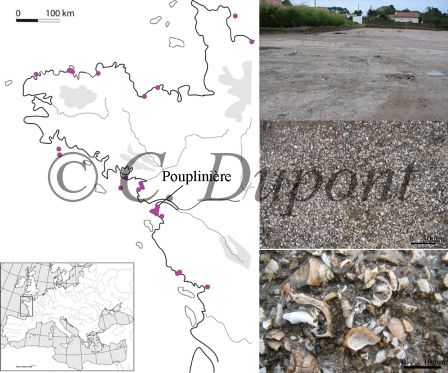Dupont C., Doyen D., 2017 – La couleur pourpre de la mer : l’extraction de colorant à partir des coquillages à Saint-Michel-Chef-Chef au 1er s. ap. J.-C. (Loire-Atlantique). In : R. González Villaescusa, K. Schörle, F. Gayet, F. Rechin (dir.) Actes des XXXVIIe Rencontres internationales d’archéologie et d’histoire d’Antibes. L’exploitation des ressources maritimes de l’Antiquité. Activités productives et organisation des territoires. Antibes – France, 10-13 octobre 2016. Éditions APDCA, Antibes, 53-66.

A gauche : carte de distribution des sites
archéologiques à production de pourpres Nucella lapillus ; à droite : Vues des concentrations de
pourpres à la Pouplinière de la vue générale à celle de détail (CNRS C. Dupont)
On the left: Map of archeological sites with production of dye with dog whelks Nucella lapillus; On the right: views of the concentrations of dog whelks in La Pouplinière from the overview to more detailed view (CNRS C. Dupont)
Résumé
La production de colorant pourpre à partir de coquillage est connue sur tous les continents. Son recensement sur le littoral atlantique français témoigne d’une activité qui existe de la protohistoire au moins jusqu’au 14ème siècle. Le site antique de la Pouplinière reste un des rares cas où la production de colorant avec des coquillages a été intégrée aux questionnements scientifiques dès la fouille. Plusieurs structures peuvent être associées à cette activité datée du 1er s. ap. J.-C. L’analyse des coquillages permet de retracer leur destin, de leur ramassage sur la grève à leur rejet. Elle témoigne d’un mode d’extraction jusque-là inédit sur le littoral atlantique : l’écrasement massif de pourpres.
Mots-clefs : pourpre, coquillage, antiquité, colorant, archéologie littorale
Summary
The production of purple dye with shell is known on all the continents. Its inventory on the French Atlantic coast testifies of an activity which exists from the Protohistory to, at least until, the 14th century. The antique site of Pouplinière is one of the rare examples where the production of dye with shells was integrated to the scientific questionings from the excavation. Several structures can be associated with this activity dated of 1st c. AD. The analysis of the shells allows to redraw their destiny, from their collecting on the seashores to their dumping. It shows a mode of extraction unpublished on the Atlantic coast: the massive crushing of purples.
Keywords: purple, shell, Antiquity, dye, maritime archaeology